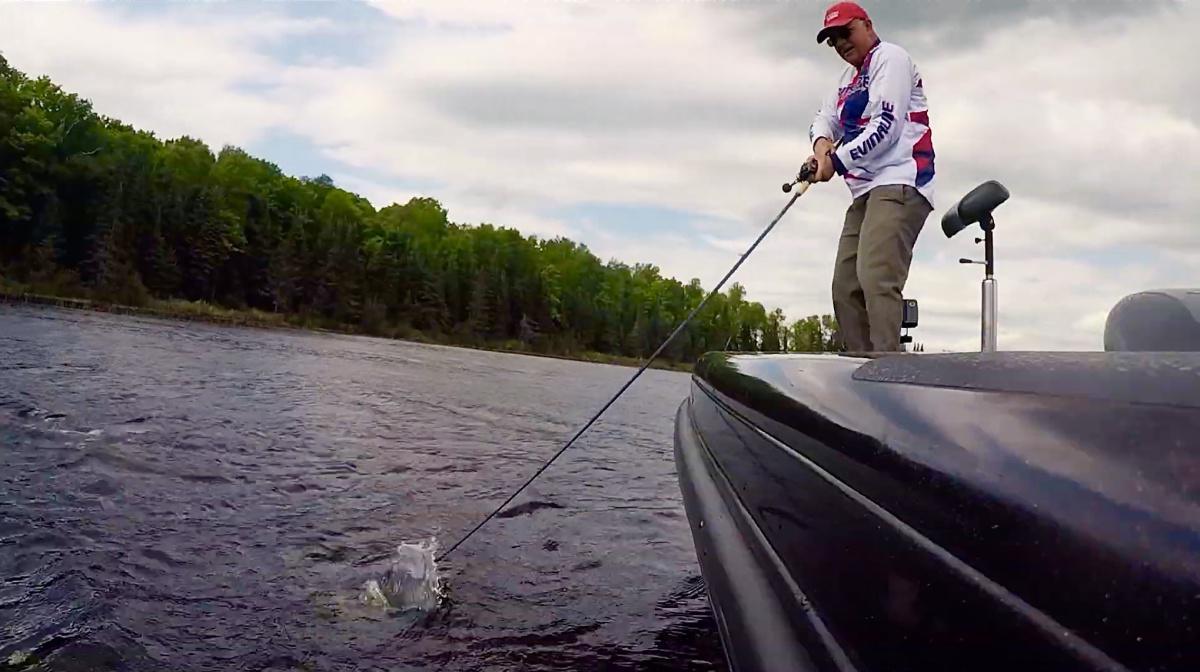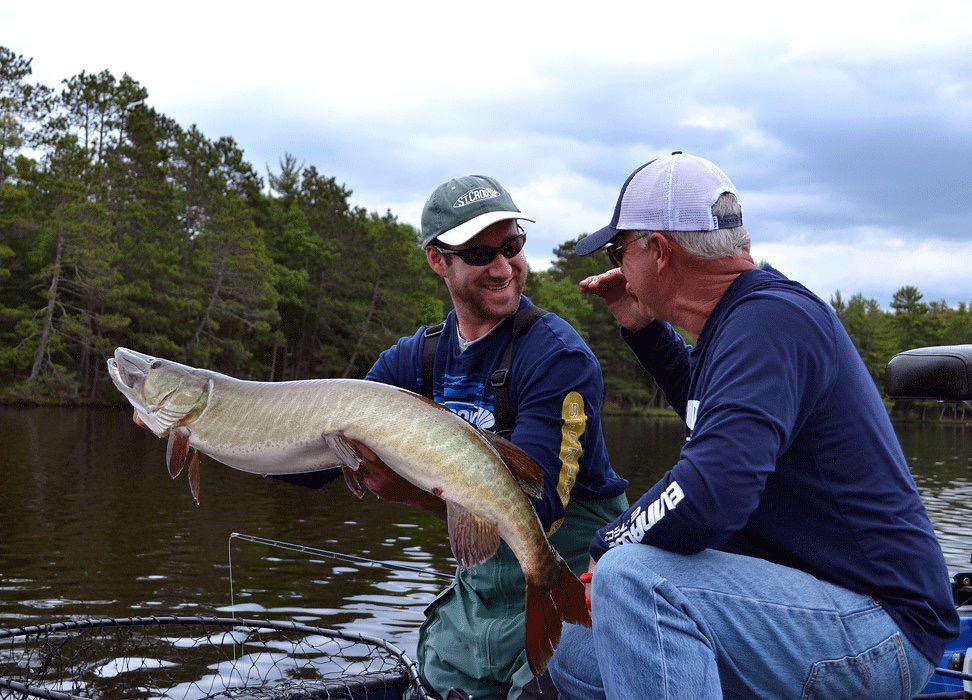Early season musky fishing is something that all us, who are musky nuts, can't wait to start doing, yet few us are truly successful at catching fish during this period of time. You've heard all the cliches "It's too early, They're still spawning, The water's too cold, We need some nice weather to get'em going. " The list goes on and on, but for the most part none of it should hinder your ability to catch your favorite fish during the early season. What you do need to know is WHERE the muskies are exactly, and WHAT conditions and lures are going to trigger them to strike.
I'm not suggesting that I have an answer to all your spring musky fishing problems by no means. There are certainly a lot waters that simply don't provide a good early season bite. But on the other hand, some waters do. Those are the ones you want to key in on. You need to find a body of water that has the right set of conditions to turn on early season muskies. Then, simply eliminate fishing any place else until these conditions change. It's just that simple.
With that in mind, here’s an example of a couple situations where I have had consistent results with early season muskies, and few reasons why these patterns are so good at this time of year.
Any time you find weed growth that is developed well early in the season, it is sure to be a musky hotspot. Beyond the obvious, that well developed early season weeds will hold muskies because of the cover, there are several less conspicuous but more important reasons why these early weeds are winners. The two that mean the most are warmer water and baitfish.
Early season weed development in any given area is a signal that this particular spot probably contains significantly warmer water. Most likely, these weeds are situated in an area receiving far more sunlight exposure enhancing the photosynthesis process. More often than not, such spots are located near the northern end of a lake or up at the back end of a long secluded shallow arm or bay. The warmer water and increased sunlight simply escalates the weed growth much like seeing one neighbor's front yard of grass growing much quicker than all those in the surrounding neighborhood.
It's important to note that the warmer water is the real attractant. Muskies and all the other fish in the area will gravitate to the warming water. Weeds might just so happen to be the cover that happens to be there. In fact, weeds could easily be replaced by any other cover element such as reeds, wood, brush or even rocks and still attract the fish with equal value. All the warm water fish species in the ecosystem will be seeking out this warm water area for spawning and feeding. Think of it as one big festival and everyone wants to be there. In fact, they are driven to be there.
Any portion of that weed patch that becomes emergent – above the water’s surface, no matter how small, is sure to be the spot-on-the-spot. Why? The answer again is simple and it is the key to so much of this early season success. Once any part of that plant breaks water, it becomes a superior heat conductor. Heat means warmer water. Warmer water means baitfish concentrations. Baitfish concentrations means MUSKY nearby! It's almost too easy in this case, and predictably accurate nearly all the time. Anytime you are fishing a shallow weed bed early in the season and notice a specific clump of that weed bed that has protruding, emergent tassels sticking out above the water's surface, casts made to that specific spot are likely to trigger a strike or a follow.
Muskies and other gamefish like bass and pike really lock on to those individual weed patches that pop out to the surface first. In addition, it really pulls the fish up vertically near the surface. I think anytime this happens it makes the fish more aggressive naturally as well as making the fish more susceptible to presentations. But the underscored factor in this unique circumstance is often what happens to the fish that muskies like to eat. Early season emergent cover draws baitfish like magnets due to their superior solar heat generation. Minnows, perch, crappies and other morsels that muskies like to munch on all lock on to these plants that are taller than the rest. The ones that pop out above the water's surface draw musky baitfish like flies. And, they will almost always be tight to the weeds and right up near the surface in order to take advantage of the warmer water and solar heat.
The best lure to fish over and around these early emerging weed patches can vary. I've had great success with a variety of lures in this instance. Traditional bucktail spinners are tough to beat initially. Especially on overcast days with any kind of a chop "wave action". Of course, it's important to cast this bait beyond the target patch so you can get it spinning fast and riding high before it reaches the weed clump itself. Otherwise, you are likely to mess up the spot by fouling your lure with weeds and destroy your chances of triggering a hot fish that is likely to be sitting right where your lure dropped. Whenever possible, always cast beyond the intended target the emergent weed clump, and retrieve the bait back towards it. This also allows you to adjust your speed and the travel level of the bait.
For submergent weed cover, it's tough to beat a minnow bait early in the season. Especially after cold fronts , whenever the skies are bright and blue. Muskies are still there, but sure to be hugging tighter to the weeds clumps and deeper. It will often take several casts to the same spot at various angles and a variety of jerks, pauses, and twitches to trigger a response. Anytime a weed patch is isolated and off shore, take the time to work it from a variety of angles. If you've raised a fish off the patch, fish it more thoroughly and slowly with a minnow bait worked in a jerkbait fashion. I can't tell you how many times I've had success with this tactic during the early season in cold fronts. These fish are just reluctant to move, yet the perfect cast and the right jerk action that puts that bait right in front of his/her nose can still trigger the strike.
This is also a key time to break out your favorite topwater plug and give it whirl. This is particularly true once the tassels of newly emerging cabbage weeds break the surface. I pulled this off most recently last spring on one of my first true musky outings of the year while filming a TV segment for our show. It was late afternoon, and the weather had been on a strong warming trend for over four days now, a great condition for early season topwater. I'd been itching to dust off a TopRaider anyway, and I had a new mallard duck pattern I was anxious to try. The weed flat I was fishing had already produced a couple of walleye shows for me earlier in the day, and I had noticed some emerging tassels on a few spots up shallow. I also noticed a lot of baitfish activity in those same patches. As I launched the first few casts I immediately went into an audio introduction of how productive these emerging weed patches can be for early season fish, as I was demonstrating how to fish a TopRaider through the surfacing tassels. Right on cue, a 43 incher roared out of the first patch I cast to and smashed the bait. I had only made two casts. After the battle and release, I repaired the wire leader, checked my line, resharpened my hooks and stood up to start this thing all over again. Within a few casts I had another musky, an even bigger 45 incher, react the same way. I had taken two nice fish and filmed one of my best segments of the year within a few casts. What a way to start the season!
Joe Bucher









